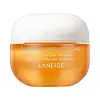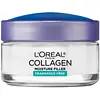What's inside
What's inside
 Key Ingredients
Key Ingredients

 Benefits
Benefits

 Concerns
Concerns

 Ingredients Side-by-side
Ingredients Side-by-side

Water
Skin Conditioning3-O-Ethyl Ascorbic Acid
Skin ConditioningGlycerin
HumectantCetearyl Alcohol
EmollientCaprylic/Capric Triglyceride
MaskingPropanediol
SolventMethyl Trimethicone
Skin ConditioningHydrogenated Poly(C6-14 Olefin)
EmollientPentaerythrityl Tetraethylhexanoate
EmollientCetearyl Olivate
Potassium Cetyl Phosphate
Emulsifying1,2-Hexanediol
Skin ConditioningSorbitan Olivate
EmulsifyingHydroxyethyl Acrylate/Sodium Acryloyldimethyl Taurate Copolymer
Emulsion StabilisingLimonene
PerfumingPolymethyl Methacrylate
Ammonium Acryloyldimethyltaurate/Beheneth-25 Methacrylate Crosspolymer
Emulsion StabilisingCitric Acid
BufferingParfum
MaskingThymol Trimethoxycinnamate
AntioxidantDisodium EDTA
Ethylhexylglycerin
Skin ConditioningSorbitan Isostearate
EmulsifyingSodium Citrate
BufferingLinalool
PerfumingTocopherol
AntioxidantMadecassoside
AntioxidantCitral
PerfumingGeraniol
PerfumingWater, 3-O-Ethyl Ascorbic Acid, Glycerin, Cetearyl Alcohol, Caprylic/Capric Triglyceride, Propanediol, Methyl Trimethicone, Hydrogenated Poly(C6-14 Olefin), Pentaerythrityl Tetraethylhexanoate, Cetearyl Olivate, Potassium Cetyl Phosphate, 1,2-Hexanediol, Sorbitan Olivate, Hydroxyethyl Acrylate/Sodium Acryloyldimethyl Taurate Copolymer, Limonene, Polymethyl Methacrylate, Ammonium Acryloyldimethyltaurate/Beheneth-25 Methacrylate Crosspolymer, Citric Acid, Parfum, Thymol Trimethoxycinnamate, Disodium EDTA, Ethylhexylglycerin, Sorbitan Isostearate, Sodium Citrate, Linalool, Tocopherol, Madecassoside, Citral, Geraniol
Water
Skin ConditioningCyclohexasiloxane
EmollientGlycerin
HumectantButyrospermum Parkii Butter
Skin ConditioningIsohexadecane
EmollientPentaerythrityl Tetraethylhexanoate
EmollientDipropylene Glycol
HumectantCera Alba
EmollientStearic Acid
CleansingPalmitic Acid
EmollientCyclopentasiloxane
EmollientAcrylamide/Sodium Acryloyldimethyltaurate Copolymer
Emulsion StabilisingPEG-100 Stearate
Stearyl Alcohol
EmollientGlyceryl Stearate
EmollientPEG-20 Stearate
EmulsifyingBoswellia Serrata Extract
Skin ConditioningManganese Gluconate
Skin ConditioningSoluble Collagen
HumectantAtelocollagen
Skin ConditioningDimethiconol
EmollientPolysorbate 80
EmulsifyingPentaerythrityl Tetraisostearate
EmollientTocopherol
AntioxidantDisodium EDTA
Sodium Hydroxide
BufferingSilica Dimethyl Silylate
EmollientSodium Chondroitin Sulfate
Skin ConditioningPhenoxyethanol
PreservativeMethylparaben
PreservativeImidazolidinyl Urea
PreservativePotassium Sorbate
PreservativeParfum
MaskingAlpha-Isomethyl Ionone
PerfumingButylphenyl Methylpropional
PerfumingBenzyl Salicylate
PerfumingLinalool
PerfumingHexyl Cinnamal
PerfumingHydroxyisohexyl 3-Cyclohexene Carboxaldehyde
MaskingCitronellol
PerfumingWater, Cyclohexasiloxane, Glycerin, Butyrospermum Parkii Butter, Isohexadecane, Pentaerythrityl Tetraethylhexanoate, Dipropylene Glycol, Cera Alba, Stearic Acid, Palmitic Acid, Cyclopentasiloxane, Acrylamide/Sodium Acryloyldimethyltaurate Copolymer, PEG-100 Stearate, Stearyl Alcohol, Glyceryl Stearate, PEG-20 Stearate, Boswellia Serrata Extract, Manganese Gluconate, Soluble Collagen, Atelocollagen, Dimethiconol, Polysorbate 80, Pentaerythrityl Tetraisostearate, Tocopherol, Disodium EDTA, Sodium Hydroxide, Silica Dimethyl Silylate, Sodium Chondroitin Sulfate, Phenoxyethanol, Methylparaben, Imidazolidinyl Urea, Potassium Sorbate, Parfum, Alpha-Isomethyl Ionone, Butylphenyl Methylpropional, Benzyl Salicylate, Linalool, Hexyl Cinnamal, Hydroxyisohexyl 3-Cyclohexene Carboxaldehyde, Citronellol
 Reviews
Reviews

Ingredients Explained
These ingredients are found in both products.
Ingredients higher up in an ingredient list are typically present in a larger amount.
Disodium EDTA plays a role in making products more stable by aiding other preservatives.
It is a chelating agent, meaning it neutralizes metal ions that may be found in a product.
Disodium EDTA is a salt of edetic acid and is found to be safe in cosmetic ingredients.
Learn more about Disodium EDTAGlycerin is already naturally found in your skin. It helps moisturize and protect your skin.
A study from 2016 found glycerin to be more effective as a humectant than AHAs and hyaluronic acid.
As a humectant, it helps the skin stay hydrated by pulling moisture to your skin. The low molecular weight of glycerin allows it to pull moisture into the deeper layers of your skin.
Hydrated skin improves your skin barrier; Your skin barrier helps protect against irritants and bacteria.
Glycerin has also been found to have antimicrobial and antiviral properties. Due to these properties, glycerin is often used in wound and burn treatments.
In cosmetics, glycerin is usually derived from plants such as soybean or palm. However, it can also be sourced from animals, such as tallow or animal fat.
This ingredient is organic, colorless, odorless, and non-toxic.
Glycerin is the name for this ingredient in American English. British English uses Glycerol/Glycerine.
Learn more about GlycerinLinalool is a fragrance and helps add scent to products. It's derived from common plants such as cinnamon, mint, citrus, and lavender.
Like Limonene, this ingredient oxidizes when exposed to air. Oxidized linalool can cause allergies and skin sensitivity.
This ingredient has a scent that is floral, spicy tropical, and citrus-like.
Learn more about LinaloolParfum is a catch-all term for an ingredient or more that is used to give a scent to products.
Also called "fragrance", this ingredient can be a blend of hundreds of chemicals or plant oils. This means every product with "fragrance" or "parfum" in the ingredients list is a different mixture.
For instance, Habanolide is a proprietary trade name for a specific aroma chemical. When used as a fragrance ingredient in cosmetics, most aroma chemicals fall under the broad labeling category of “FRAGRANCE” or “PARFUM” according to EU and US regulations.
The term 'parfum' or 'fragrance' is not regulated in many countries. In many cases, it is up to the brand to define this term.
For instance, many brands choose to label themselves as "fragrance-free" because they are not using synthetic fragrances. However, their products may still contain ingredients such as essential oils that are considered a fragrance by INCI standards.
One example is Calendula flower extract. Calendula is an essential oil that still imparts a scent or 'fragrance'.
Depending on the blend, the ingredients in the mixture can cause allergies and sensitivities on the skin. Some ingredients that are known EU allergens include linalool and citronellol.
Parfum can also be used to mask or cover an unpleasant scent.
The bottom line is: not all fragrances/parfum/ingredients are created equally. If you are worried about fragrances, we recommend taking a closer look at an ingredient. And of course, we always recommend speaking with a professional.
Learn more about ParfumPentaerythrityl Tetraethylhexanoate is an emollient that helps make your skin smooth and hydrated. It specializes in creating a non-oily and "wet" feeling on skin.
This ingredient comes from isostearic acid, a saturated fatty acid. It is a synthetic ingredient.
Tocopherol (also known as Vitamin E) is a common antioxidant used to help protect the skin from free-radicals and strengthen the skin barrier. It's also fat soluble - this means our skin is great at absorbing it.
Vitamin E also helps keep your natural skin lipids healthy. Your lipid skin barrier naturally consists of lipids, ceramides, and fatty acids. Vitamin E offers extra protection for your skin’s lipid barrier, keeping your skin healthy and nourished.
Another benefit is a bit of UV protection. Vitamin E helps reduce the damage caused by UVB rays. (It should not replace your sunscreen). Combining it with Vitamin C can decrease sunburned cells and hyperpigmentation after UV exposure.
You might have noticed Vitamin E + C often paired together. This is because it is great at stabilizing Vitamin C. Using the two together helps increase the effectiveness of both ingredients.
There are often claims that Vitamin E can reduce/prevent scarring, but these claims haven't been confirmed by scientific research.
Learn more about TocopherolWater. It's the most common cosmetic ingredient of all. You'll usually see it at the top of ingredient lists, meaning that it makes up the largest part of the product.
So why is it so popular? Water most often acts as a solvent - this means that it helps dissolve other ingredients into the formulation.
You'll also recognize water as that liquid we all need to stay alive. If you see this, drink a glass of water. Stay hydrated!
Learn more about Water